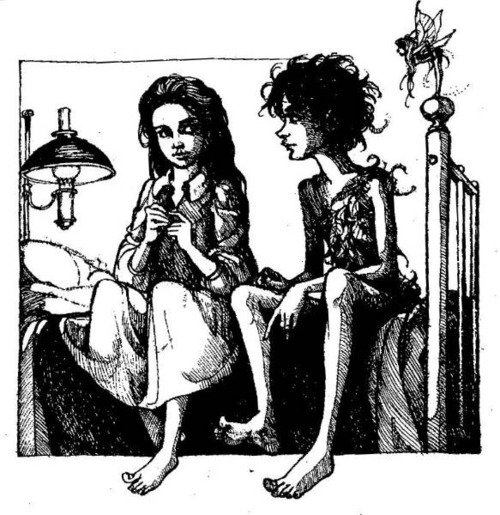All children, except one, grow up. [...] You always know after you are two. Two is the beginning of the end.
~ Peter and Wendy, by J.M. Barrie, opening paragraph
So why even review it? If all that I could say upon the topic has been said numerous times before, why clutter up the vast expanse of the internet with worn-out reviews.
Because it's great, that’s why.
Why, after all, does everyone know the story of Peter Pan—even if they haven’t read it—except for the simple reason that it is wonderful? The story, like many classic Children’s Literature, speaks to us even after we are grown (which we all know we must do, after we are two) because it is about childhood, and adulthood, and the painful process of leaving one and entering another.
 |
| Illustration by Trina Schart Hyman, 1980 Source: http://25.media.tumblr.com/tumblr_me7x4xX7891r5pvhvo1_500.jpg |
Peter, is a symbol of childhood in all its “heartlessness”
and carefree vivacity. People have only
seen the Disney cartoon may be shocked at how Barrie portrays children as
heartless. This doesn’t mean the children
don’t have feelings. It means that they
are absorbed in their own feelings so much that they lack the complex ability
to empathize with others. This phenomena
is connected to Piaget’s Preoperational Stage in Developmental Psychology…which
coincidentally is the only part of that college course I remember. The
other children of the book—Wendy, John, Michael, and the Lost Boys—eventually
grow out of this “heartlessness”, but in order to do that they have to grow. Peter Pan, on the other hand, doesn’t grow up, and therefore never sheds
his egocentrism (“O the cleverness of me!”).
What
might also shock new readers of the novel is the persona of the narrator.
Nowadays people aren’t used to the narrator directly addressing them, or
suddenly switching to present-tense to describe a scene as if the narrator were
taking the reader by the hand and leading them to peek around the corner at
events as they unfold. And modern
readers are certainly not used to the third-person narrator having a mind of
his own, voicing opinions and killing off pirates on a whim to demonstrate how
ruthless and evil Captain Hook can be.
Barrie employs all these unfamiliar narrative techniques—and probably
more—throughout his novel. Peter Pan is
heartless, and the narrator reflects that.
The darkness that sometimes infiltrates the story reflects the darkness
of having childhood ripped forcibly from the characters by the mere ongoing of
time, and those character being burdened by acquiring complex emotional
maturity, such as empathy and the knowledge of their own mortality.
But Peter
and Wendy ends with hope. If every child
must grow out of that magical state that defines childhood, that doesn’t mean
that the magic dies. It gets passed from
one generation to another, and the magic will continue, “as long as children
are young and and heartless.”
Suggested Reading Age: 8+
Parental Notes: Captain Hook is not nearly so silly as in
the Disney animation. In his first scene
he disembowels one of his lackeys. Also,
Tinker Bell isn’t the sweet fairy that launched an entire spinoff franchise:
she’s a vain thing with a tendency to swear.
Availability: Peter and Wendy is available free on
Kindle but is worth investing in a hardcover copy.
This novel has lent itself to some gorgeous illustrators from which you
can choose, such as Arthur Rackham
and Trina Schart Hyman.
Further Notes: If you’re looking for a good adaptation,
skip the animated 1953 movie and go for the 2003 live-action movie.

And in the original, there's a casual remark that the fairies were off having an orgy! I do love the illustrations by Trina Schart Hyman. One of my favorite artists.
ReplyDelete